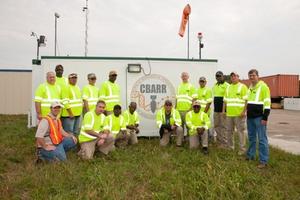Food securityU.S. Army helps in chemical testing of meat product
When a South Dakota beef producer voiced concerns over the safety of its product to a meat inspection staff, the Animal Disease Research and Diagnostic Laboratory at South Dakota State University, called on the U.S. Army Research, Development and Engineering Command’s chemical-biological center (ECBC) – and the ECBC answered.

The U.S. Army's CBARR unit performed key meat safety testing // Source: army.mil
When a South Dakota beef producer voiced concerns over the safety of its product to a meat inspection staff, the Animal Disease Research and Diagnostic Laboratory (ADRDL) at South Dakota State University (SDSU), called on the Food Emergency Response Network (FERN) for help in early January. Within a few days, the U.S. Army Research, Development and Engineering Command’s chemical-biological center, or ECBC, answered. “It was really great,” said Laura Ruesch, research associate II at SDSU. “I would have had no way of knowing that [Edgewood Chemical Biological Center] existed if it weren’t for the [Food Emergency Response Network]. It was a really great way to connect people who have the resources and similar interest in food testing, but otherwise would not have had contact with one another.”
A U.S Army release reports that the Food Emergency Response Network, known as FERN, an integrated system of food-testing laboratories across local, state, and federal levels in the United States, facilitated the partnership between SDSU and ECBC’s CBARR[Chemical Biological Applications & Risk Reduction] Business Unit laboratories at the Aberdeen Proving Ground, Maryland. Federal and state funding cuts caused SDSU’s biochemistry laboratory to close in 2011, leaving the university without the facility or personnel to support a core chemistry capability for food testing. Furthermore, the absence of a Department of Agriculture laboratory in South Dakota left Ruesch with little state resources to reach out to. Instead, she utilized her contacts within FERN to connect to CBARR’s Environmental Chemical Monitoring Laboratory.
As part of South Dakota’s meat inspection program, SDSU needed to conduct additional chemical testing on a meat sample to determine whether or not Ivermectin, an anti-parasitic agent, was present. According to Ruesch, the Ivermectin compound is used in a pesticide that is poured on live cattle to control internal and external parasites such as roundworms, cattle grubs, mites, lice and flies.
“Typically, there is a withdrawal period of 45 days before they can slaughter that animal,” Ruesch said.
“Whatever product was absorbed into the body of the cow was processed by the liver and kidneys and excreted via feces and urine so levels present in the tissue are reduced to tolerable levels.”
The meat sample in question, however, had been processed before the 45-day time period, after only twenty-eight days.
Additional testing was conducted by CBARR to ensure the meat sample was not contaminated and the Ivermectin compound was not still present. The anti-parasitic agent is
